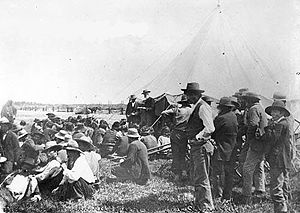 David Laird explaining terms of Treaty 8, Fort Vermilion, 1899 | |
| Signed | June 21, 1899 |
|---|---|
| Location | Just south of present-day Grouard, Alberta[1] |
| Parties |
|
| Languages | English |
| Indigenous peoples in Canada |
|---|
 |
|
|

Treaty 8, which concluded with the June 21, 1899, signing by representatives of the Crown and various First Nations of the Lesser Slave Lake area, is the most comprehensive of the eleven Numbered Treaties.[2] The agreement encompassed a land mass of approximately 840,000 km2 (320,000 sq mi). Treaty territory, which includes thirty-nine First Nation communities in northern Alberta, northwestern Saskatchewan, northeastern British Columbia, and the southwest portion of the Northwest Territories, making it the largest of the numbered treaty in terms of area. The treaty was negotiated just south of present-day Grouard, Alberta.
The Crown had between 1871 and 1877 signed Treaties 1 to 7. Treaties 1 to 7 cover the southern portions of what was the North-West Territories. At that time, the Government of Canada had not considered a treaty with the First Nations in what would be the Treaty 8 territory necessary, as conditions in the north were not considered conducive to settlement.[citation needed] Along with the Douglas Treaties, Treaty 8 was the last treaty signed between the Crown and the First Nations in British Columbia until the Nisga'a Final Agreement.
The boundary between Treaty 8 and Treaty 11 is ambiguous. The Yellowknives Dene First Nation is a signatory to Treaty 8, but according to the text of the treaties the Yellowknives Nation's territory, known as Chief Drygeese Territory, is within Treaty 11.
- ^ "The Making of Treaty 8 in Canada's Northwest". Alberta Online Encyclopedia. 2009. Archived from the original on May 15, 2009. Retrieved August 1, 2009.
- ^ Cite error: The named reference
Treaty8was invoked but never defined (see the help page).
© MMXXIII Rich X Search. We shall prevail. All rights reserved. Rich X Search
